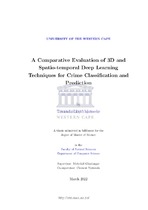| dc.contributor.advisor | Ghaziasgar, Mehrdad | |
| dc.contributor.author | Matereke, Tawanda Lloyd | |
| dc.date.accessioned | 2022-03-09T09:22:10Z | |
| dc.date.available | 2022-03-09T09:22:10Z | |
| dc.date.issued | 2021 | |
| dc.identifier.uri | http://hdl.handle.net/11394/8858 | |
| dc.description | >Magister Scientiae - MSc | en_US |
| dc.description.abstract | This research is on a comparative evaluation of 3D and spatio-temporal deep learning
methods for crime classification and prediction using the Chicago crime dataset, which
has 7.29 million records, collected from 2001 to 2020. In this study, crime classification
experiments are carried out using two 3D deep learning algorithms, i.e., 3D Convolutional
Neural Network and the 3D Residual Network. The crime classification models
are evaluated using accuracy, F1 score, Area Under Receiver Operator Curve (AUROC),
and Area Under Curve - Precision-Recall (AUCPR). The effectiveness of spatial grid resolutions
on the performance of the classification models is also evaluated during training,
validation and testing. | en_US |
| dc.language.iso | en | en_US |
| dc.publisher | University of Western Cape | en_US |
| dc.subject | Crime classification | en_US |
| dc.subject | Chicago crime dataset | en_US |
| dc.subject | 3D deep learning algorithms | en_US |
| dc.subject | 3D residual network | en_US |
| dc.subject | Crime | en_US |
| dc.title | A comparative evaluation of 3d and spatio-temporal deep learning techniques for crime classification and prediction | en_US |
| dc.rights.holder | University of Western Cape | en_US |

